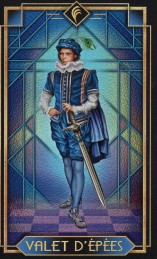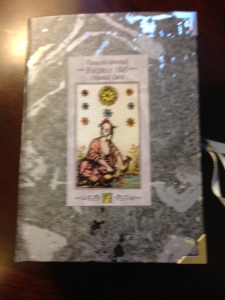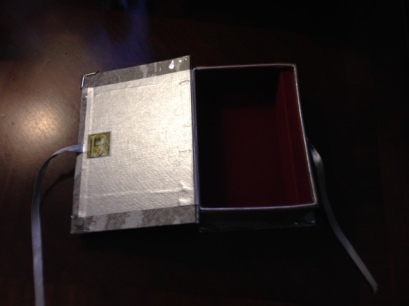Tarot Decoratif
Author: Ciro Marchetti
Artist: Ciro Marchetti
Independently Published
2016

“A Tarot deck if a magical illustrated book like no other.
Every time you open its cover it offers you a different
and unique story.”
from the companion PDF
The Tarot Decoratif is a 78 card deck that combines features from both the Marseilles and Waite-Smith schools of Tarot. It is self-published as a Special Edition, aimed primarily at collectors. The images follow traditional images close enough that the deck can be used easily for reading, if one is familiar with the Tarot. Marchetti is a digital artist, with several decks to his credit (Legacy of the Divine Tarot, Tarot of Dreams, Tarot Royale, The Gilded Tarot) – all of which are unique and outstanding in their own way.

This Special Edition comes with a plethora of goodies – a signed signature card; a themed, satin lined bag; and a heavy, black, lift top box. (I am partial to black – I find the box stunning!) Reading cloths are also available for separate purchase. The option to personalize the card backs is no longer available, as the cards have already gone to the printer. There is no companion book, but there is a PDF available for download in which Marchetti describes the thought process (rational) for his personal design choices.
A small note about the PDF: I fully appreciate hearing the “story behind the story”. Seeing what is in the mind of the creator as he is creating. Those who have followed Marchetti’s work know that each of his projects is stand-alone, with vibrant energy and compelling story-lines. Many of us know that Marchetti had effectively “retired” from creating Tarot decks, and was focusing on Kipper and Lenormand oracles. He was nudged into changing his mind when he attended a presentation by Russell Sturgess at a TarotCon in West Palm Beach. Sturgess presented what to Marchetti was an entertaining and compelling view of the history of the Marseilles Tarot, the core of which was that its symbolic content was a “hidden in plain sight” reproduction of the religious beliefs of the Cathars, as expressed through the imagery of the Major Arcana. Hence, the interest to create a Marseilles based Tarot was ignited. To maintain the integrity of the deck, Marchetti reached out to a select group of people (including readers, publishers, authors, and artists of Marseilles style decks) that are acknowledged to be experienced voices in the world of the Marseilles Tarot.
Marchetti talks about the early woodcut decks, and how commercial appeal would have factored into the production of the decks. In designing the Tarot Decoratif, imagery from multiple decks was cross-referenced, as well as interpretations and views from various sources. The imagery that made the most sense was then chosen to be used. The result is imagery that is decorative, but still easily recognizable, and easily read.

The Tarot Decoratif is a reflection of Marchetti’s personal style, and personal choices. While deeply imbued in the Marseilles style, there is enough imagery to make it interesting to those that find it a bit difficult to read with icons only.
While reading the PDF is not necessary to understanding this deck, I found it of personal interest. I did not agree with all of it, and you may not either, but it does give us insight into why the imagery in this deck is presented in the manner that it is.

The cards are 3 ¼” by 5 ¼”, on a glossy card stock finish. There is a contrasting matt spot varnish over the outer border design. The backs have a black background, with gold inner borders and imagery, and are reversible. The card faces show a black background, with the same dual gold borders as the card backs. The Major Arcana (Trumps) show the card number, in Roman Numerals, centered at the top of the card. The card title, in French, is centered at the bottom of the card. The card of Death is numbered, but not titled.
The Court cards show the insignia for the character centered at the top of the card, with the card title and suit centered at the bottom of the card. The pips (numbered cards) show the card number, in Roman Numerals, centered at the top of the card, with the suit name centered at the bottom of the card.

The card imagery is bold, with bright, intense colors. The pips are Marseilles style, with icons and no imagery, with the exception of a single image in the top, middle or bottom of the card. For example, the IV of Deniers shows the top of a male figure in the center of the card, with a shield beneath it. The X of Deniers shows treasure chest in the middle of the card, while the VI of Batons shows a rider seated on a horse centered at the top of the card.

There is interesting symbolism throughout the deck, including three dice in mid-air in Le Bateleur, the Alepha and Omega signs on the page of the book in Le Pape, the cherub over the male figure in L’Amoureux, the flaming cauldron between the male and female figures in Le Diable, the family pictured in the IV of Batons, and the male figure appearing to study in the VIII of Deniers.
This is a vibrant, well done deck that would be a welcome addition to any Tarot collection, both from a collector’s point of view, and from a reader’s point of view.
© October 2016 Bonnie Cehovet
Reproduction prohibited without written permission of the author.














